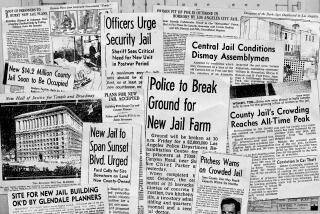Women Who End Up Inside Find Friends on the Outside
- Share via
The mother of a 3-month-old baby was frantic. She had been arrested for an illegal drug sale she had no part in.
She spent several days in jail because she could not afford to post the $500 bail, and she worried about her baby, whom she had left with a neighbor.
She had good reason to worry.
The neighbor panicked when the woman did not return from her job at a fast-food restaurant to pick up the infant and called police, thinking the baby might have been abandoned. Police sent child-welfare officials out to pick up the infant, and the neighbor, in her panic, gave them an incorrect name for the baby’s mother. The infant was lost in the system.
The complaint is a common one for volunteers of Friends Outside in Los Angeles Inc. who hear from inmates at Sybil Brand Institute--Los Angeles County’s jail for women. Sybil Brand is the largest women’s jail in the United States, with a fluctuating population as high as 2,400.
Friends Outside is a nonprofit volunteer organization with 19 chapters in the state that checks on the welfare of the families of female jail inmates.
Charges Later Dropped
The frantic woman--a true story told by Jacquelyn Long, executive director of Friends Outside--was about to be charged by police with abandoning her baby before Friends Outside stepped in.
They tracked the baby’s movement through the system and located it in a foster home. Charges were dropped against the woman for lack of evidence after she spent nearly three months in jail.
The jail time cost her her job, her apartment (for failure to pay rent) and custody of her baby until she obtained a new place to live. Several months later, with the help of Friends Outside, she found a place to live and got her baby back.
Such stories of desperation have motivated Joyce Ride, president of the board of Friends Outside in Los Angeles, to write a recent letter to the editor in The Times.
“Los Angeles County incarcerates many more women than New York and Chicago combined,” Ride wrote. “We boast the largest institution for women in the free world.”
Ride’s figures are confirmed by attorney Rebecca Juarado, director of the Women Prisoners’ Rights Program of the American Civil Liberties Union.
“Los Angeles is a very, very large county,” Juarado said. “It incarcerates--I can’t say at a greater rate--but at a high rate. I don’t know why there are more women inside prison in California than anywhere in the nation. The state level (excluding county facilities like Sybil Brand) is about 3,600 women.”
Awaiting Misdemeanor Trials
Ride says the reason there are so many women in jail in Los Angeles County is because many are awaiting trial for such misdemeanors as shoplifting or writing bad checks, or for offenses related to mental illness.
“Unnecessary and-or inappropriate incarceration of people reveals the level of civilization in a community,” she wrote in her letter. “We all share in the blame. Why can’t a woman, who must wait two or three months for trial and who doesn’t represent a threat to society, remain at her job, or at home until her trial?”
Friends Outside has applied for a $15,000 matching grant from the National Presbyterian Women organization to train 20 volunteers to work with the criminal justice system to find alternatives to incarceration, Ride said.
“We are unique in that we are permitted in to visit the inmates and can speak with some authority on the problem and it’s something we feel very strongly about,” Ride said.
Neither she nor Long blame any particular agency for women who get caught in the cracks of the criminal justice system.
“We’re not pointing fingers,” Long said. “It’s not a cruel Sheriff’s Department or a cruel judge. It’s just the system as a whole. There’s got to be some options. The system sees black and white, and either you violated the law or you didn’t.”
Both women would like to see more women who are charged with misdemeanors released on their own recognizance, or O.R. Los Angeles County judges decide who is eligible for the O.R. program, based on various criteria assessing how likely a defendant is to appear at her next court hearing.
In some counties, such as Alameda and San Francisco, Friends Outside has administered O.R. programs, Ride said.
“It saves the county a great deal of money, besides saving trauma to the lives of the inmate’s family,” she said. “It’s a real boon to the taxpayers.
“Even when convicted, there are alternatives to spending time in jail depending on the crime. A lot more could be done in that way.”
The Sybil Brand Institute, designed to hold slightly more than 900 women, has “severe problems of overcrowding,” Juarado said.
A county task force of judges is studying new alternatives to incarceration, including the use of electronic monitoring devices to make sure inmates under house arrest do not wander off.
Sgt. Richard Barrantes of the planning and research unit in the Sheriff’s Department custody division said jail overcrowding is putting pressure on the courts and the department to find alternatives to incarceration, such as work furlough programs and community service work.
More to Read
Sign up for Essential California
The most important California stories and recommendations in your inbox every morning.
You may occasionally receive promotional content from the Los Angeles Times.









